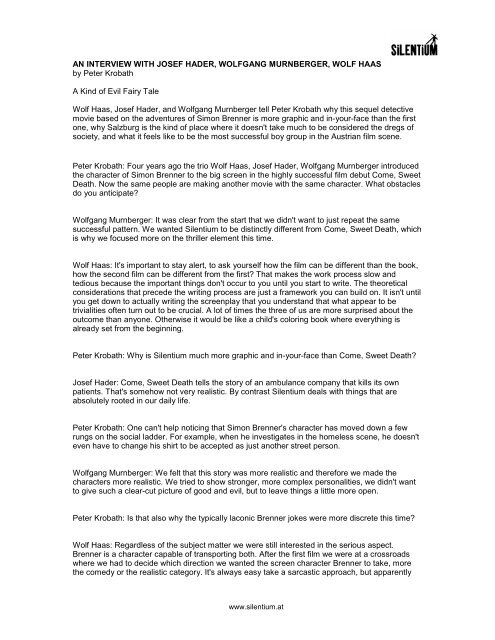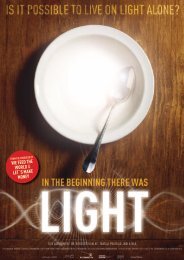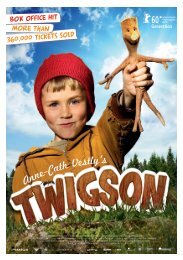Create successful ePaper yourself
Turn your PDF publications into a flip-book with our unique Google optimized e-Paper software.
AN INTERVIEW WITH JOSEF HADER, WOLFGANG MURNBERGER, WOLF HAAS<br />
by Peter Krobath<br />
A Kind of Evil Fairy Tale<br />
Wolf Haas, Josef Hader, and Wolfgang Murnberger tell Peter Krobath why this sequel detective<br />
movie based on the adventures of Simon Brenner is more graphic and in-your-face than the first<br />
one, why Salzburg is the kind of place where it doesn't take much to be considered the dregs of<br />
society, and what it feels like to be the most successful boy group in the Austrian film scene.<br />
Peter Krobath: Four years ago the trio Wolf Haas, Josef Hader, Wolfgang Murnberger introduced<br />
the character of Simon Brenner to the big screen in the highly successful film debut Come, Sweet<br />
Death. Now the same people are making another movie with the same character. What obstacles<br />
do you anticipate?<br />
Wolfgang Murnberger: It was clear from the start that we didn't want to just repeat the same<br />
successful pattern. We wanted Silentium to be distinctly different from Come, Sweet Death, which<br />
is why we focused more on the thriller element this time.<br />
Wolf Haas: It's important to stay alert, to ask yourself how the film can be different than the book,<br />
how the second film can be different from the first? That makes the work process slow and<br />
tedious because the important things don't occur to you until you start to write. The theoretical<br />
considerations that precede the writing process are just a framework you can build on. It isn't until<br />
you get down to actually writing the screenplay that you understand that what appear to be<br />
trivialities often turn out to be crucial. A lot of times the three of us are more surprised about the<br />
outcome than anyone. Otherwise it would be like a child's coloring book where everything is<br />
already set from the beginning.<br />
Peter Krobath: Why is Silentium much more graphic and in-your-face than Come, Sweet Death?<br />
Josef Hader: Come, Sweet Death tells the story of an ambulance company that kills its own<br />
patients. That's somehow not very realistic. By contrast Silentium deals with things that are<br />
absolutely rooted in our daily life.<br />
Peter Krobath: One can't help noticing that Simon Brenner's character has moved down a few<br />
rungs on the social ladder. For example, when he investigates in the homeless scene, he doesn't<br />
even have to change his shirt to be accepted as just another street person.<br />
Wolfgang Murnberger: We felt that this story was more realistic and therefore we made the<br />
characters more realistic. We tried to show stronger, more complex personalities, we didn't want<br />
to give such a clear-cut picture of good and evil, but to leave things a little more open.<br />
Peter Krobath: Is that also why the typically laconic Brenner jokes were more discrete this time?<br />
Wolf Haas: Regardless of the subject matter we were still interested in the serious aspect.<br />
Brenner is a character capable of transporting both. After the first film we were at a crossroads<br />
where we had to decide which direction we wanted the screen character Brenner to take, more<br />
the comedy or the realistic category. It's always easy take a sarcastic approach, but apparently<br />
www.silentium.at





